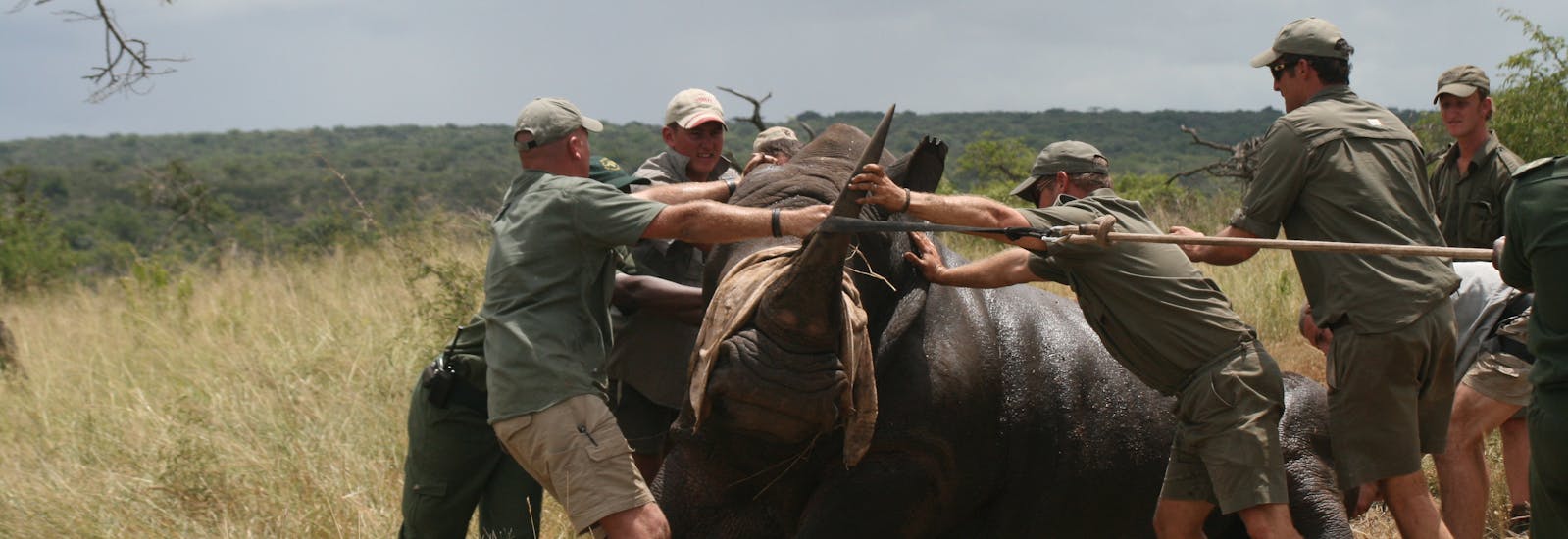
Catch of the day
It’s been a busy season for the Game Capture Team! The work of this group of specialists and the volunteers that lend hands-on support is notoriously unpredictable: They travel across the country, working at many different sites and with a wide variety of wildlife species. It is not enough that they are often contacted at short notice to give a hand with moving wildlife between reserves – the weather also constantly has a hand in disrupting their work – just as they might have finished setting up a big net enclosure in the field, the wind might change, alerting the animals to their presence, or the clouds open up, making a capture too risky. If that happens, it’s back to the drawing board for everyone…
With all this uncertainty, you might be wondering what exactly they have been up to over the last few weeks. Here is a look at their recent adventurous activities – and all the excitement our volunteers got to share!
Lots and lots of rhinos
Rhinos are a fairly frequent “client” with the game capture team, but their capture is always exciting! At first, the vet on site darts the rhino with a strong sedative. Once the animal is down, volunteers and the vet check the rhino’s well-being and vital signs. Moving these giant animals is a real team effort – walking next to them makes you appreciate their size!
General game
A lot of the captures involve “plains game” or “general game” – usually herds of various antelope species. Herd capture is labour-intensive and exciting work. As you are dealing with large numbers of stressed animals all at once, the capture needs to be planned meticulously. For herd captures, the team and volunteers usually set up a large, funnel-shaped net enclosure in the bush. As it can stretch to over 100 metres, many hands are needed to construct it!
Once the capture is underway, the more experienced volunteers are stationed on the ground, helping to herd the antelopes along the net channel and towards the trucks – it can hardly get more exciting than being surrounded by dozens of racing and jumping wild animals! “Fresh arrivals” or less confident volunteers start off working on the trucks. Once the animals enter the trucks, the volunteers count them, check them for injuries and then give the necessary treatment. Volunteers learn to administer the tranquillizers using pole syringes. All stressed animals and male animals receive a tranquillizer called stresnill or haloperidol before travelling long distances to their new home.
Giraffe capture
Giraffe are amongst the species that the Game Capture Team frequently work with. You only need to look at their size and awkward body shape to know that it takes a lot of skill and experience to catch these animals – not to mention the tricky business of loading them onto a vehicle and moving them to a different reserve. As a first step, the vet darts the giraffe with a sedative, which is usually done from a helicopter.
Giraffes have a very low tolerance for sedatives. Due to their unusual physique, their blood pressure is very unstable, and there is only a short window during which they can be sedated. In that timeframe, the team ropes the giraffe loosely, so that it can be controlled but still moves on its own accord. The animal is also blindfolded. This is a necessary step that reduces the stress for the animals – as the sedative impairs their movements, it would be quite traumatic for them to see people moving around them, without being able to react naturally. The sedative is then reversed, and with the giraffe back on its feet, the tricky operation of handling a scared animal with very long legs and razor-sharp hooves starts!
Vet intervention
It is routine procedure to have a vet present on captures that involve the powerful sedatives used for darting wildlife. Sometimes, the capture team is alerted by wildlife reserve owners because an animal needs to be caught to receive treatment for injuries. Such was the case with a rare leopard capture and an accident-prone giraffe.
Predators are a rather uncommon case for our capture team, but 6 lucky volunteers were involved in a leopard capture when a game reserve owner spotted an injured leopard and alerted the game capture team. They set up cages to capture it, and after 6 weeks were successful. It just goes to show how much waiting and patience can be involved in this adrenaline-fuelled industry! The leopard’s wounds were treated and he was taken to a local wildlife rehabilitation centre for recovery.
Another case involved a giraffe that had stepped onto a water pipe – and then walked around with the broken pipe stuck to its leg for several days. The capture team moved in, sedated the giraffe, removed the mangled water pipe remains and treated the cuts to the giraffe’s foot with antiseptics.

